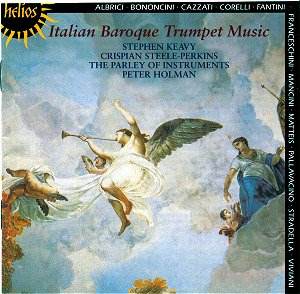The trumpet is one of the oldest instruments in history.
It was already in use in ancient Egypt as well as in Assyria
and Israel. Mostly used as a military instrument it held that
position well into our Western music history. Until the 17th
century it was mainly there to play fanfare-like music. Monteverdi
was one of the first composers to use it in one of his compositions:
the Toccata which precedes his first opera, Orfeo. As with
most trumpeters in those days the four players of the trumpets
in the Toccata were army officers.
The Toccata didn't have any relationship with the opera
itself: it was played to pay tribute to the Gonzaga family
of Mantua, at whose court Orfeo was first performed. This
points into the direction of an important role the trumpet
was to play for the next two centuries. It was frequently
used in compositions written in honour of kings, queens and
princes. Hence we find one or more trumpets in ceremonial
music as written by, for instance, Purcell, Handel and Charpentier.
But it was also used in honour of the heavenly King, as many
settings of the Te Deum show. And it doesn't surprise that
Bach used trumpets in the opening chorus of his Christmas
Oratorio, which relates the birth of King Jesus.
The music we find on this disc is of another kind. People
who know the trumpet only in its modern form will be surprised
to find music for trumpet and basso continuo, or with only
two violins. But the natural trumpets as they are played here
are much softer than their modern counterparts. Even so the
balance between the trumpet and the other instruments was
something of concern to composers, as the trumpet manual of
1638 by Fantini shows: for his sonatas for trumpet with basso
continuo only he suggests the use of a mute in case the basso
continuo is played on the harpsichord rather than the organ.
During the 17th century composers started to write highly
sophisticated music for the trumpet. The players of the instruments
weren't army officers anymore, but professional musicians.
One of the main centres of trumpet playing and composing was
Bologna. Cazzati, Franceschini and Bononcini were all associated
in one way or another with Bologna. Even Corelli must have
become acquainted with the Bolognese school of trumpet playing,
as he was born in Fusignano, in the immediate environment
of Bologna. His sonata is the only piece for another instrument
than strings he ever composed. It was written for an English
trumpeter, who visited Rome, where Corelli worked for the
largest part of his life.
Italian composers also used the trumpet in overtures to
oratorios and operas, and the programme brings two specimens
of such overtures, the Sinfonias by Pallavicino and Mancini.
Matteis was a Neapolitan composer who went to England, and
worked there as a player, composer and teacher of both violin
and guitar. The piece here is a reconstruction of three movements
from a suite for strings. The booklet doesn't tell what reasons
there are to assume this piece was originally intended for
trumpets. It is particularly strange that the third solo part
couldn't be performed on a trumpet and is therefore played
on the trombone.
The first item on the disc is a delightful piece which
reflects Stradella's qualities as composer of vocal music,
in particular in the second movement, entitled 'aria'. Another
remarkable piece is the Suonate a 7 by Franceschini, who specified
its scoring with cello, trombone, double bass, theorbo and
organ.
One of the reasons for the invention of the keyed trumpet
in the 18th century was that it was very difficult to play
the natural trumpet in tune. One wonders how big that problem
was. Is it reasonable to assume that composers continued to
write demanding music for the trumpet if it was impossible
to play the instrument in tune, at least to a reasonable extent?
Anyway, one has to admire the players of those days, since
their modern counterparts are not able to play the natural
trumpet without adaptations. That is what happens here: both
players make use of copies of historical instruments, but
adaptations have been made to improve the intonation; hence
the secure intonation heard on this disc.
This doesn't diminish my admiration for Crispian Steele-Perkins
and Stephen Keavy in any way, as even with adaptations the
natural trumpet remains one of the most difficult instruments
to play, and both do so admirably. I am also happy with the
stylish and committed playing of the Parley of Instruments.
The programme has been put together quite nicely, bringing
together some of the best music by Italian composers of the
17th century, which is still hardly available on other recordings.
I wholeheartedly recommend this disc. I shall certainly
return to it from time to time, and I am sure anyone buying
this disc is going to do the same.
Johan
van Veen

![]() Crispian Steele-Perkins, Stephen Keavy (natural trumpet)
Crispian Steele-Perkins, Stephen Keavy (natural trumpet)![]() HELIOS CDH55192
[53:35]
HELIOS CDH55192
[53:35]





